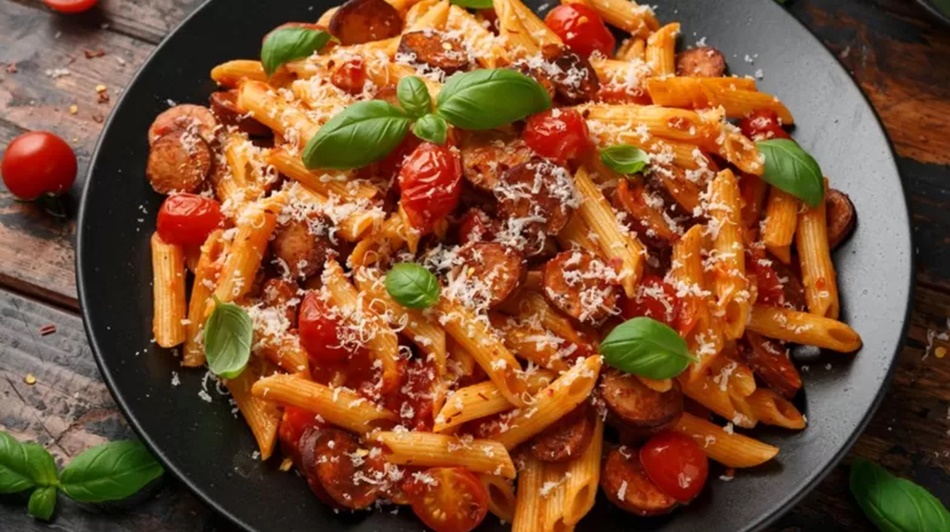How healthy is eating pasta (How it affects your weight)
One popular dieting technique is to draw up a food blacklist, in which it's common to skip "carbs" or packaged foods, which may mean avoiding pasta.

But do we really need to cut out pasta to improve our diets?
This is what we call a reductionist approach to nutrition, where we describe a food in terms of just one of its key components.
Pasta is not just carbs. One cup (about 145 grams) of cooked pasta has about 38 grams of carbohydrates, 7.7 grams of protein, and 0.6 grams of fat. In addition, there is all the water that is absorbed when cooking and many vitamins and minerals.
“But pasta is mostly carbs!” I hear you sob. It is true, but it is not the whole story. We have to think about the context.
Your day on a plate
You probably know that there are recommendations for how much energy (kilojoules or calories) we should eat in a day. These recommendations are based on body size, gender, and physical activity. But you may not realize that there are also recommendations for the macronutrient profile, or types of foods, that supply this energy.
Fats, carbohydrates, and proteins are macronutrients. Macronutrients are broken down in the body to produce energy for our bodies.
Acceptable macronutrient distribution ranges describe the proportion or percentage of macronutrients that should provide this energy. These ranges are established by experts based on health outcomes and healthy eating patterns.
The goal is to make sure we get enough, but not too much of each macro. Consuming too much or too little of any type of food can have health consequences.
The ratios are also designed to ensure that we get enough vitamins and minerals that come with energy in the foods we normally eat. We should get 45-65% of our energy from carbohydrates, 10-30% from protein, and 20-35% from fat.
Mangia pasta
The macronutrient ratios mean that it can be healthy to eat up to 1.2 to 6.5 times more carbohydrates in a day than protein, since each gram of protein has the same amount of energy as one gram of carbohydrates.
The ratio of carbohydrates to protein in pasta is 38 grams to 7.7 grams, which is about a 5 to 1 ratio, which is well within the acceptable range of macronutrient distribution and means that pasta actually has enough protein to balance the carbs.
This is not only due to the eggs that the pasta contains. Wheat is another source of protein and makes up about 20% of the protein consumed worldwide.
The relationship between calorie levels and weight gain is not that simple either.
In the context of a healthy diet, it has been shown that people lose more weight when pasta is regularly included in their diet. And, a systematic review of ten different studies found that pasta was better for post-meal blood glucose levels than bread or potatoes.
Instead of giving up spaghetti, you should consider reducing your portion sizes or switching to whole-wheat pasta, which is higher in fiber, which offers gut health benefits and can help you feel full longer.
Gluten-free pasta has slightly less protein than wheat pasta. So despite being healthier for those with a gluten intolerance, there are no major health benefits to switching to gluten-free pasta for most of us.
With pesto and bolognese
Pasta is not usually eaten alone either. So while some warn about the dangers of blood sugar spikes when eating “naked carbs” (meaning just carbs with no other food), this is generally not a risk for pasta.
When pasta provides the base of a meal, it can be a vehicle to help people eat more vegetables in sauces or with chunks. For kids (or fussy adults), pasta sauce can be a great place to hide mashed or shredded vegetables.
Not eating just pasta is also important for your protein profile. Plant foods are generally not complete proteins, which means that we need to eat combinations of them to get all the different types of amino acids (the building blocks of protein) that we need to survive.
But pasta, while we often focus on carbs and energy, packs a good nutritional punch. Like most foods, they are not just macronutrients, they also have micronutrients.
One cup of cooked pasta has about a quarter of the recommended daily intake of vitamins B1 and B9, half of the recommended intake of selenium, and 10% of our iron needs.
The news about pasta gets even better when we eat it as leftovers.
When pasta cooks and cools, some of the carbohydrates turn into resistant starch. This starch gets its name from being resistant to digestion, so it provides less energy and is better for blood sugar levels. So leftover pasta, even if you reheat it, has fewer calories than it did the night before.
To look more at the ‘carb’ options
There’s a lot of talk about cutting down on carbs for weight loss, but you have to remember that carbs come in different forms and in different foods.
Some of them, like pasta, provide other benefits. Others like cakes and sweets, they add little. When it comes to reducing your intake of refined carbohydrates, one should think first of all about sweets that are eaten plain, before cutting out the basic carbohydrates that are often served with vegetables, possibly the healthiest core food group!
The real recipe for pasta alla norma as in Sicily
Italians never eat spaghetti bolognese

